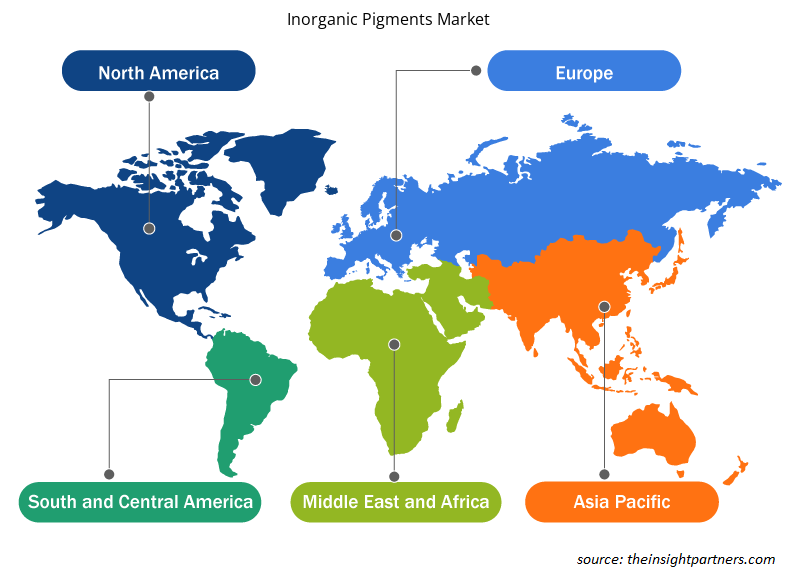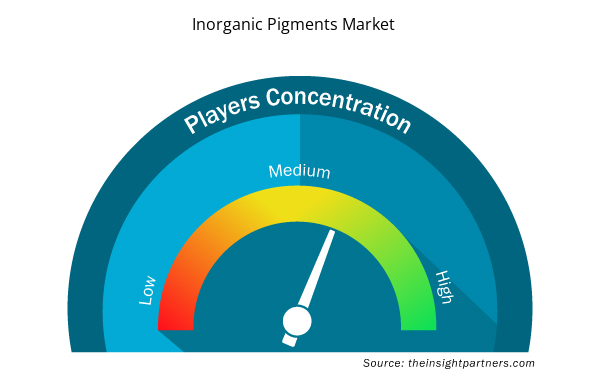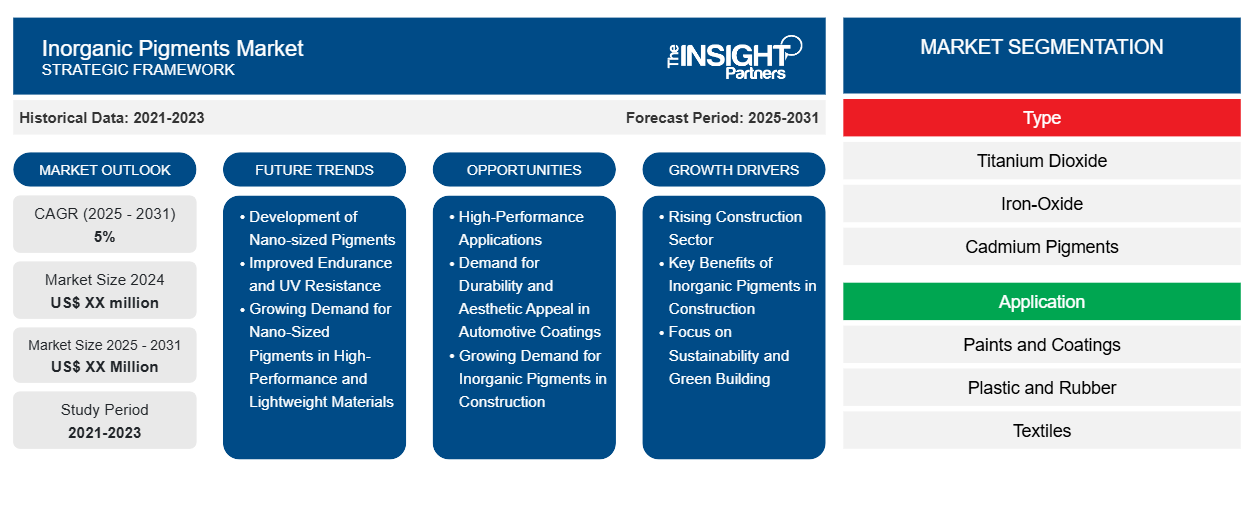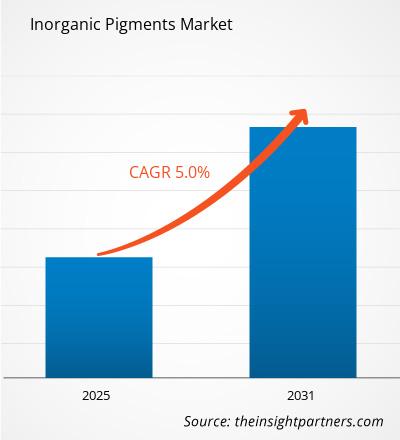Se espera que el mercado de pigmentos inorgánicos registre una CAGR del 5% entre 2023 y 2031, con un tamaño de mercado que se expandirá de US$ XX millones en 2023 a US$ XX millones en 2031.
El informe presenta un análisis basado en el tipo (dióxido de titanio, óxido de hierro, pigmentos de cadmio, pigmentos de cromo y otros). El informe está segmentado por aplicación (pinturas y revestimientos, plástico y caucho, textiles, tintas de impresión, cosméticos y otros). El análisis global se desglosa aún más a nivel regional y por países principales. El tamaño del mercado y el pronóstico a nivel global, regional y de país para todos los segmentos clave del mercado están cubiertos bajo el alcance. El informe ofrece el valor en USD para el análisis y los segmentos anteriores. El informe proporciona estadísticas clave sobre el estado del mercado de los actores clave del mercado y ofrece tendencias y oportunidades del mercado.
Propósito del Informe
El informe Inorganic Pigments Market de The Insight Partners tiene como objetivo describir el panorama actual y el crecimiento futuro, los principales factores impulsores, los desafíos y las oportunidades. Esto proporcionará información a diversas partes interesadas del negocio, como:
- Proveedores/fabricantes de tecnología: Para comprender la dinámica cambiante del mercado y conocer las oportunidades potenciales de crecimiento, lo que les permitirá tomar decisiones estratégicas informadas.
- Inversionistas: Realizar un análisis exhaustivo de tendencias sobre la tasa de crecimiento del mercado, las proyecciones financieras del mercado y las oportunidades que existen en toda la cadena de valor.
- Órganos reguladores: Regular las políticas y vigilar las actividades del mercado con el objetivo de minimizar los abusos, preservar la confianza de los inversores y defender la integridad y estabilidad del mercado.
Segmentación del mercado de pigmentos inorgánicos
Tipo
- Dióxido de titanio
- Óxido de hierro
- Pigmentos de cadmio
- Pigmentos de cromo
Solicitud
- Pinturas y recubrimientos
- Plástico y caucho
- Textiles
- Tintas de impresión
- Productos cosméticos
Personalice este informe según sus necesidades
Obtendrá personalización en cualquier informe, sin cargo, incluidas partes de este informe o análisis a nivel de país, paquete de datos de Excel, así como también grandes ofertas y descuentos para empresas emergentes y universidades.
- Obtenga las principales tendencias clave del mercado de este informe.Esta muestra GRATUITA incluirá análisis de datos, desde tendencias del mercado hasta estimaciones y pronósticos.
Factores impulsores del crecimiento del mercado de pigmentos inorgánicos
- Sector de la construcción en auge: Un factor de crecimiento fundamental para el mercado de pigmentos inorgánicos es el creciente sector de la construcción. La urbanización acelera el aumento de los proyectos de infraestructura y, en todo el mundo, habrá una creciente necesidad de pinturas y revestimientos o materiales de construcción de mejor calidad. Varias aplicaciones de pigmentos inorgánicos aportarán durabilidad, opacidad y colores brillantes a las construcciones.
- Principales beneficios de los pigmentos inorgánicos en la construcción: Los pigmentos inorgánicos son los preferidos en los sectores de la construcción principalmente por su excelente resistencia a la intemperie y a la luz. Esto garantiza que las superficies pintadas mantengan su apariencia durante largos períodos de tiempo, lo que los convierte en la opción preferida para todas las aplicaciones, tanto interiores como exteriores; y a medida que los constructores se centran en acabados duraderos y estéticamente agradables, se desarrollan más demandas de estos pigmentos.lightfastness of the pigments. It ensures that painted surfaces hold their appearance over long durations of time, giving it a preference for all applications, interior and exterior; and as builders focus on durable and aesthetically pleasing finishes, more demands for these pigments are developed.
- Enfoque en la sostenibilidad y la construcción ecológica: la tendencia hacia la conservación del medio ambiente a través de la construcción ecológica ha dado un impulso a los pigmentos inorgánicos. En ese contexto, la mayoría de ellos se derivan de minerales u otras fuentes naturales, disolventes no tóxicos. Estos pigmentos responden a la creciente preocupación de que las industrias de la construcción han comenzado a dar importancia a la sostenibilidad, mientras que su incorporación a los artículos manufacturados amplía aún más el mercado.
Tendencias futuras del mercado de pigmentos inorgánicos
- Desarrollo de pigmentos de tamaño nanométrico: los pigmentos de tamaño nanométrico son la última tendencia en el mercado de pigmentos inorgánicos. El tamaño de partícula ultrafino les otorga propiedades mejoradas, como mayor intensidad de color y opacidad. Por lo tanto, ofrecen una cobertura más eficiente y requieren una menor cantidad de pigmento en las formulaciones.Nano-sized Pigments: Nano-sized pigments are the latest trend in the inorganic pigments market. The ultra-fine particle size gives them improved properties such as better color strength and opacity. They, therefore, offer more efficient coverage and require less amount of pigment in formulations.
- Mayor resistencia y resistencia a los rayos UV: además de estos beneficios, los pigmentos de tamaño nanométrico contribuyen a una mayor resistencia y estabilidad para muchas aplicaciones diferentes. El tamaño de sus partículas y las propiedades de su superficie dan lugar a una mayor resistencia a la degradación por rayos UV y a la intemperie, por lo que se utilizan para revestimientos y pinturas destinadas a exponerse a un entorno más duro. Esta mejora es especialmente interesante para las industrias orientadas a acabados más duraderos y de mejor calidad.
- Demanda creciente de pigmentos de tamaño nanométrico en materiales ligeros y de alto rendimiento: los pigmentos de tamaño nanométrico también se utilizan en materiales ligeros y de alto rendimiento, que están en aumento. En las industrias automotriz y aeroespacial, la necesidad de reducción de peso hace que los pigmentos puedan ayudar a mejorar el rendimiento del producto y, al mismo tiempo, reducir el uso de material. Esta tendencia también respalda las iniciativas de sustentabilidad, ya que la reducción del uso de pigmentos puede ayudar a reducir el impacto ambiental.
Oportunidades de mercado de pigmentos inorgánicos
- Aplicaciones de alto rendimiento: Las aplicaciones de alto rendimiento serán las principales oportunidades de crecimiento para el mercado de pigmentos inorgánicos. Las industrias automotriz, aeroespacial y de la construcción exigen cada vez más durabilidad, resistencia a los rayos UV y estabilidad térmica superiores. Los pigmentos inorgánicos cumplen mejor con estos requisitos al ofrecer colores vivos y un rendimiento duradero en condiciones difíciles.
- Demanda de durabilidad y atractivo estético en los recubrimientos para automóviles: la industria automotriz, por ejemplo, está siendo testigo de un aumento en la demanda de recubrimientos de calidad que puedan soportar condiciones extremas. Los pigmentos inorgánicos ofrecen una buena retención del color y protección contra la decoloración, lo que los hace ideales para aplicaciones exteriores e interiores. La tendencia está obligando a los fabricantes a invertir en fórmulas avanzadas de pigmentos para mejorar el atractivo estético y la vida útil del vehículo.
- Demanda creciente de pigmentos inorgánicos en la construcción: La industria de la construcción también se centra en materiales de alto rendimiento que garanticen durabilidad y sostenibilidad. Los pigmentos inorgánicos ayudan a la eficiencia energética, ya que permiten revestimientos reflectantes, que reducen la cantidad de calor absorbido dentro del edificio, mejorando así el rendimiento energético del edificio. La creciente atención hacia las prácticas de construcción ecológica amplía el mercado de pigmentos inorgánicos de alto rendimiento.
Perspectivas regionales del mercado de pigmentos inorgánicos
Los analistas de Insight Partners explicaron en detalle las tendencias y los factores regionales que influyen en el mercado de pigmentos inorgánicos durante el período de pronóstico. Esta sección también analiza los segmentos y la geografía del mercado de pigmentos inorgánicos en América del Norte, Europa, Asia Pacífico, Oriente Medio y África, y América del Sur y Central.

- Obtenga datos regionales específicos para el mercado de pigmentos inorgánicos
Alcance del informe de mercado de pigmentos inorgánicos
| Atributo del informe | Detalles |
|---|---|
| Tamaño del mercado en 2023 | XX millones de dólares estadounidenses |
| Tamaño del mercado en 2031 | US$ XX millones |
| CAGR global (2023 - 2031) | 5% |
| Datos históricos | 2021-2022 |
| Período de pronóstico | 2024-2031 |
| Segmentos cubiertos | Por tipo
|
| Regiones y países cubiertos | América del norte
|
| Líderes del mercado y perfiles de empresas clave |
|
Densidad de actores del mercado de pigmentos inorgánicos: comprensión de su impacto en la dinámica empresarial
El mercado de pigmentos inorgánicos está creciendo rápidamente, impulsado por la creciente demanda de los usuarios finales debido a factores como la evolución de las preferencias de los consumidores, los avances tecnológicos y una mayor conciencia de los beneficios del producto. A medida que aumenta la demanda, las empresas amplían sus ofertas, innovan para satisfacer las necesidades de los consumidores y aprovechan las tendencias emergentes, lo que impulsa aún más el crecimiento del mercado.
La densidad de actores del mercado se refiere a la distribución de las empresas o firmas que operan dentro de un mercado o industria en particular. Indica cuántos competidores (actores del mercado) están presentes en un espacio de mercado determinado en relación con su tamaño o valor total de mercado.
Las principales empresas que operan en el mercado de pigmentos inorgánicos son:
- Carl Schlenk AG
- Industrias Cathay
- Corporación Ferro
- Heubach GmbH
- Kronos Worldwide, Inc
Descargo de responsabilidad : Las empresas enumeradas anteriormente no están clasificadas en ningún orden particular.

- Obtenga una descripción general de los principales actores clave del mercado de pigmentos inorgánicos
Puntos de venta clave
- Cobertura integral: el informe cubre de manera integral el análisis de productos, servicios, tipos y usuarios finales del mercado de pigmentos inorgánicos, proporcionando un panorama holístico.
- Análisis de expertos: el informe se compila sobre la base de un profundo conocimiento de expertos y analistas de la industria.
- Información actualizada: El informe asegura relevancia comercial debido a su cobertura de información reciente y tendencias de datos.
- Opciones de personalización: este informe se puede personalizar para satisfacer los requisitos específicos del cliente y adaptarse adecuadamente a las estrategias comerciales.
Por lo tanto, el informe de investigación sobre el mercado de pigmentos inorgánicos puede ayudar a abrir camino para descifrar y comprender el escenario de la industria y las perspectivas de crecimiento. Si bien puede haber algunas preocupaciones válidas, los beneficios generales de este informe tienden a superar las desventajas.
- Análisis histórico (2 años), año base, pronóstico (7 años) con CAGR
- Análisis PEST y FODA
- Tamaño del mercado Valor/volumen: global, regional, nacional
- Industria y panorama competitivo
- Conjunto de datos de Excel


- Virtual Production Market
- Electronic Toll Collection System Market
- Redistribution Layer Material Market
- Procedure Trays Market
- Industrial Inkjet Printers Market
- Architecture Software Market
- Wire Harness Market
- Green Hydrogen Market
- Authentication and Brand Protection Market
- Cell Line Development Market

Report Coverage
Revenue forecast, Company Analysis, Industry landscape, Growth factors, and Trends

Segment Covered
This text is related
to segments covered.

Regional Scope
North America, Europe, Asia Pacific, Middle East & Africa, South & Central America

Country Scope
This text is related
to country scope.
Preguntas frecuentes
The development of nano-sized pigments is expected to be the key market trends.
Based on geography, Asia Pacific held the largest share of the inorganic pigments market due to rapid industrialization and urbanization in countries such as China and India have led to an increased demand for construction materials, automotive products, and consumer goods. This surge in various industries directly drives the need for high-quality pigments.
Based on type, the titanium dioxide segment is expected to witness the fastest growth during the forecast period
The expanding construction industry are driving the market growth.
BASF SE; LANXESS; Tata Pigments; Tronox Holdings Plc; The Chemours Company; Vibrantz; LB Group; Kronos Worldwide, Inc.; Heubach GmbH; and INEOS are some of the key players operating in the inorganic pigments market
The Inorganic Pigments Market is estimated to witness a CAGR of 5% from 2023 to 2031
Trends and growth analysis reports related to Chemicals and Materials : READ MORE..
1.Carl Schlenk AG
2.Cathay Industries
3.Ferro Corporation
4.Heubach GmbH
5.Kronos Worldwide, Inc
6.Lanxess
7.Tata Pigments
8.The Chemours Company
9.Tronox Holdings plc
10.Venator Materials PLC.
The Insight Partners performs research in 4 major stages: Data Collection & Secondary Research, Primary Research, Data Analysis and Data Triangulation & Final Review.
- Data Collection and Secondary Research:
As a market research and consulting firm operating from a decade, we have published and advised several client across the globe. First step for any study will start with an assessment of currently available data and insights from existing reports. Further, historical and current market information is collected from Investor Presentations, Annual Reports, SEC Filings, etc., and other information related to company’s performance and market positioning are gathered from Paid Databases (Factiva, Hoovers, and Reuters) and various other publications available in public domain.
Several associations trade associates, technical forums, institutes, societies and organization are accessed to gain technical as well as market related insights through their publications such as research papers, blogs and press releases related to the studies are referred to get cues about the market. Further, white papers, journals, magazines, and other news articles published in last 3 years are scrutinized and analyzed to understand the current market trends.
- Primary Research:
The primarily interview analysis comprise of data obtained from industry participants interview and answers to survey questions gathered by in-house primary team.
For primary research, interviews are conducted with industry experts/CEOs/Marketing Managers/VPs/Subject Matter Experts from both demand and supply side to get a 360-degree view of the market. The primary team conducts several interviews based on the complexity of the markets to understand the various market trends and dynamics which makes research more credible and precise.
A typical research interview fulfils the following functions:
- Provides first-hand information on the market size, market trends, growth trends, competitive landscape, and outlook
- Validates and strengthens in-house secondary research findings
- Develops the analysis team’s expertise and market understanding
Primary research involves email interactions and telephone interviews for each market, category, segment, and sub-segment across geographies. The participants who typically take part in such a process include, but are not limited to:
- Industry participants: VPs, business development managers, market intelligence managers and national sales managers
- Outside experts: Valuation experts, research analysts and key opinion leaders specializing in the electronics and semiconductor industry.
Below is the breakup of our primary respondents by company, designation, and region:

Once we receive the confirmation from primary research sources or primary respondents, we finalize the base year market estimation and forecast the data as per the macroeconomic and microeconomic factors assessed during data collection.
- Data Analysis:
Once data is validated through both secondary as well as primary respondents, we finalize the market estimations by hypothesis formulation and factor analysis at regional and country level.
- Macro-Economic Factor Analysis:
We analyse macroeconomic indicators such the gross domestic product (GDP), increase in the demand for goods and services across industries, technological advancement, regional economic growth, governmental policies, the influence of COVID-19, PEST analysis, and other aspects. This analysis aids in setting benchmarks for various nations/regions and approximating market splits. Additionally, the general trend of the aforementioned components aid in determining the market's development possibilities.
- Country Level Data:
Various factors that are especially aligned to the country are taken into account to determine the market size for a certain area and country, including the presence of vendors, such as headquarters and offices, the country's GDP, demand patterns, and industry growth. To comprehend the market dynamics for the nation, a number of growth variables, inhibitors, application areas, and current market trends are researched. The aforementioned elements aid in determining the country's overall market's growth potential.
- Company Profile:
The “Table of Contents” is formulated by listing and analyzing more than 25 - 30 companies operating in the market ecosystem across geographies. However, we profile only 10 companies as a standard practice in our syndicate reports. These 10 companies comprise leading, emerging, and regional players. Nonetheless, our analysis is not restricted to the 10 listed companies, we also analyze other companies present in the market to develop a holistic view and understand the prevailing trends. The “Company Profiles” section in the report covers key facts, business description, products & services, financial information, SWOT analysis, and key developments. The financial information presented is extracted from the annual reports and official documents of the publicly listed companies. Upon collecting the information for the sections of respective companies, we verify them via various primary sources and then compile the data in respective company profiles. The company level information helps us in deriving the base number as well as in forecasting the market size.
- Developing Base Number:
Aggregation of sales statistics (2020-2022) and macro-economic factor, and other secondary and primary research insights are utilized to arrive at base number and related market shares for 2022. The data gaps are identified in this step and relevant market data is analyzed, collected from paid primary interviews or databases. On finalizing the base year market size, forecasts are developed on the basis of macro-economic, industry and market growth factors and company level analysis.
- Data Triangulation and Final Review:
The market findings and base year market size calculations are validated from supply as well as demand side. Demand side validations are based on macro-economic factor analysis and benchmarks for respective regions and countries. In case of supply side validations, revenues of major companies are estimated (in case not available) based on industry benchmark, approximate number of employees, product portfolio, and primary interviews revenues are gathered. Further revenue from target product/service segment is assessed to avoid overshooting of market statistics. In case of heavy deviations between supply and demand side values, all thes steps are repeated to achieve synchronization.
We follow an iterative model, wherein we share our research findings with Subject Matter Experts (SME’s) and Key Opinion Leaders (KOLs) until consensus view of the market is not formulated – this model negates any drastic deviation in the opinions of experts. Only validated and universally acceptable research findings are quoted in our reports.
We have important check points that we use to validate our research findings – which we call – data triangulation, where we validate the information, we generate from secondary sources with primary interviews and then we re-validate with our internal data bases and Subject matter experts. This comprehensive model enables us to deliver high quality, reliable data in shortest possible time.


 Obtenga una muestra gratuita de este informe
Obtenga una muestra gratuita de este informe